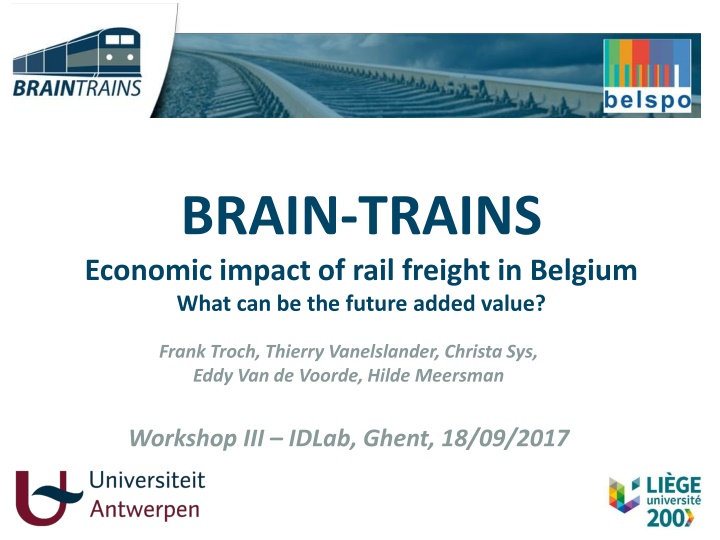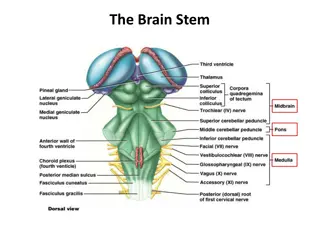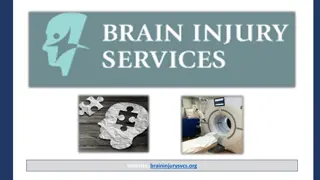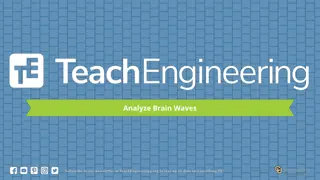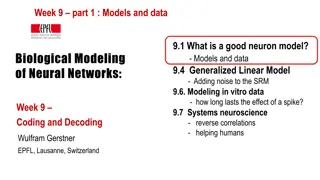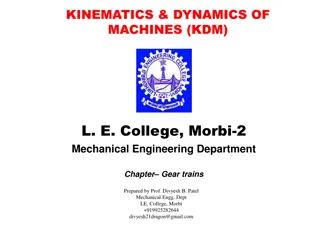BRAIN-TRAINS
Delve into the economic analysis of rail freight in Belgium, exploring the direct and indirect impacts on companies and sectors. Understand how added value and employment parameters play a crucial role in determining the strategic significance of freight transport. Dive into the research methodology and calculations involved in quantifying the economic impact at various levels. Gain valuable insights into the potential future added value of rail freight in Belgium.
Download Presentation

Please find below an Image/Link to download the presentation.
The content on the website is provided AS IS for your information and personal use only. It may not be sold, licensed, or shared on other websites without obtaining consent from the author.If you encounter any issues during the download, it is possible that the publisher has removed the file from their server.
You are allowed to download the files provided on this website for personal or commercial use, subject to the condition that they are used lawfully. All files are the property of their respective owners.
The content on the website is provided AS IS for your information and personal use only. It may not be sold, licensed, or shared on other websites without obtaining consent from the author.
E N D
Presentation Transcript
BRAIN-TRAINS Economic impact of rail freight in Belgium What can be the future added value? Frank Troch, Thierry Vanelslander, Christa Sys, Eddy Van de Voorde, Hilde Meersman Workshop III IDLab, Ghent, 18/09/2017
Agenda Introduction: Scope and objective of economic part Introduction Part 1: Direct economic impact (company) Part 2: Indirect economic impact (sector) Part 1 Feedback and discussion Part 2 Discussion 2
Introduction Why an economic analysis? Freight transport Direct Economic value Introduction Rest of the economy Indirect Strategic significance Part 1 Objective Quantify direct & indirect economic impact Analyse company & sectoral level Development of economic indicators based on added value and employment parameters Part 2 Discussion 3
Introduction Approach Introduction Work in progress Part 1 Scope of the presentation Part 2 Discussion 4
1. Direct economic impact Research methodology: Added value analysis Economic indicators (Vanstraelen, 2015) Introduction ?????????? ???????????????? ???????????????? = Part 1 ?????????? ??????????????? (???) ??????????????????????????? = Part 2 ?????????? ??????????????? = ??????????????? (???????) Discussion 5
1. Direct economic impact Research methodology: Added value analysis Added value calculation Introduction BOTTOM-UP Part 1 Part 2 Discussion 6
1. Direct economic impact Research methodology: Added value analysis Added value calculation Introduction TOP-DOWN Part 1 - 640/8 70/74 - 740 - 60/61 - 695 + 640 GROSS ADDED VALUE (market prices) Raw materials, consumables, services and other goods Director s entitlements Operational income Company subsidies Other Taxes Part 2 operational costs Discussion 7
1. Direct economic impact Research methodology: Added value analysis Added value calculation Introduction TOP-DOWN - shortened Part 1 70/74 operational income 60/61 input purchases Gross added value Part 2 TOP-DOWN - adapted Exclude provisions for costs and risks (635/7) Discussion 8
1. Direct economic impact Data collection Introduction Period 1990 2009: Historic data Statistical yearbooks B-cargo (NMBS Logistics) part of NMBS group (national organization) Part 1 Period 2010 2015: Recent data Annual accounts B Logistics (Lineas) independent organization Part 2 Discussion 9
1. Direct economic impact Results Rail freight employment (Incumbent operator) Introduction 3000 2853 2500 Part 1 2195 2000 Rail freight employment (FTE) 1500 Part 2 1000 680 500 449 470 228 Discussion 267 97 0 2003 1993 1994 1995 1996 1997 1998 1999 2000 2001 2002 2004 2005 2006 2007 2008 2009 2010 2011 2012 2013 2014 2015 10
1. Direct economic impact Results Gross added value in factor costs (incumbent operator) 200 Millions Introduction Part of NMBS Liberalized 175 Gross added value incumbent operator 150 Part 1 125 No joint cost allocation 100 Transition period (factor costs) BOTTOM-UP 75 TOP-DOWN Belgian rail freight market liberalized 50 TOP-DOWN (short) Part 2 Financial and economic crisis 25 TOP-DOWN (adaptation) 0 -25 Discussion -50 -75 2005 2006 2007 2008 2009 2010 2011 2012 2013 2014 2015 11
1. Direct economic impact Results Added value (competition comparison) Introduction Crisis + Part 1 Competition Recovery Part 2 Discussion 12
1. Direct economic impact Results Economic indicators (incumbent operator) Added value / FTE Introduction Part 1 Part 2 Discussion 13
1. Direct economic impact Results Economic indicators (incumbent operator) Added value / tkm Introduction Part 1 Part 2 Discussion 14
1. Direct economic impact Results Economic indicators (incumbent operator) Added value range Introduction Part 1 Part 2 Discussion 15
1. Direct economic impact Results Economic indicators (competition comparison) Introduction Part 1 Part 2 Discussion 16
2. Indirect economic impact Research methodology: Input-Output analysis Example simplified supply table Introduction Part 1 Example simplified demand table Part 2 Discussion 17
2. Indirect economic impact How to read the INPUT-OUTPUT table? Top bottom = INPUT reading: Column sector is using x from row sector Left right = OUTPUT reading: Row sector is supplying x to column sector Introduction Part 1 Part 2 Discussion 18
2. Indirect economic impact What to do with an INPUT-OUTPUT table ? Leontief Multiplier Direct + Indirect economic effects of a sector F.Ex. 1.06 for car sector = For each additional unit of final demand, the total output for the economy will increase by 1.06 Introduction Part 1 What about the rail freight sector ? Included in general sector 49 Land Transport in the national input-output table Research approach: split sector 49 into rail freight transport and other land transport Part 2 Discussion 19
2. Indirect economic impact Assumptions: Companies are only buying and selling products or services linked to their primary NACE classification Introduction The activities and structure of B Logistics have not shifted significantly from 2010 to 2011 Part 1 There is no final rail freight demand from households and the government Part 2 B Logistics is not applying handling margins within selling prices and no direct subsidies are received Discussion 20
2. Indirect economic impact Results: Introduction Input Strong link with other land transport, transport supporting activities & business administration Part 1 Output Strong link with other land transport, transport supporting activities & metal industry Part 2 Leontief approximation Rail freight transport multiplier = 2.985 Other sectors: average from original = 0.02 Discussion 21
Conclusion and discussion Conclusions: Direct impact is increasing, should not be stopped ! Introduction Indirect impact is approximated to be high Part 1 Data collection is challenging Clear regulation Cooperation to make a strong case Uniformity should be guarded Governmental collection enforcement Further research: Parameters investment and capacity Part 2 Discussion 22
Thank you for your attention. Questions? BRAIN-TRAINS BELSPO project
